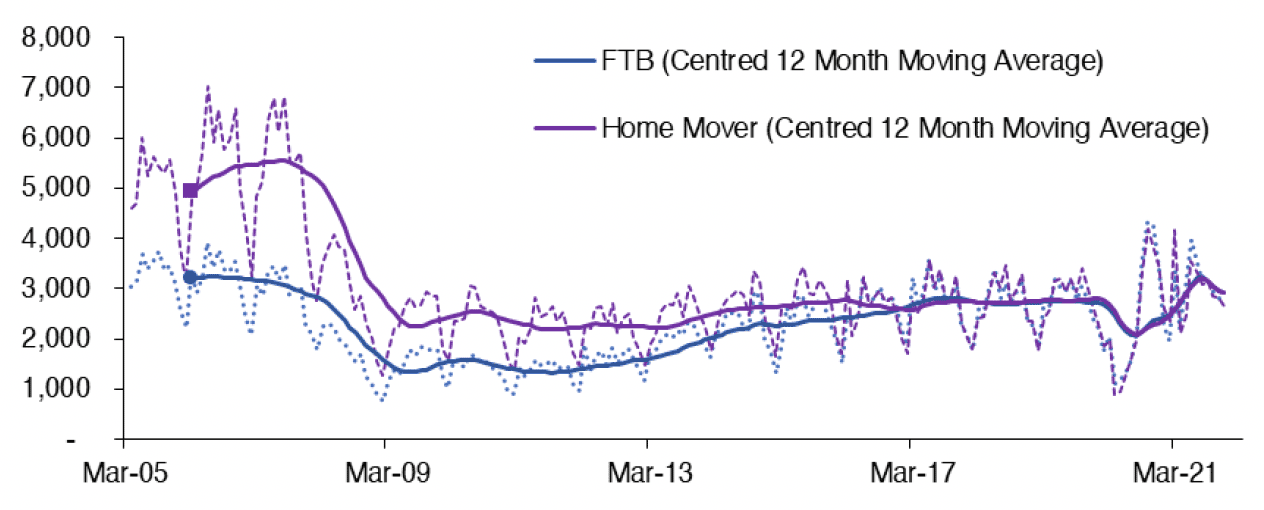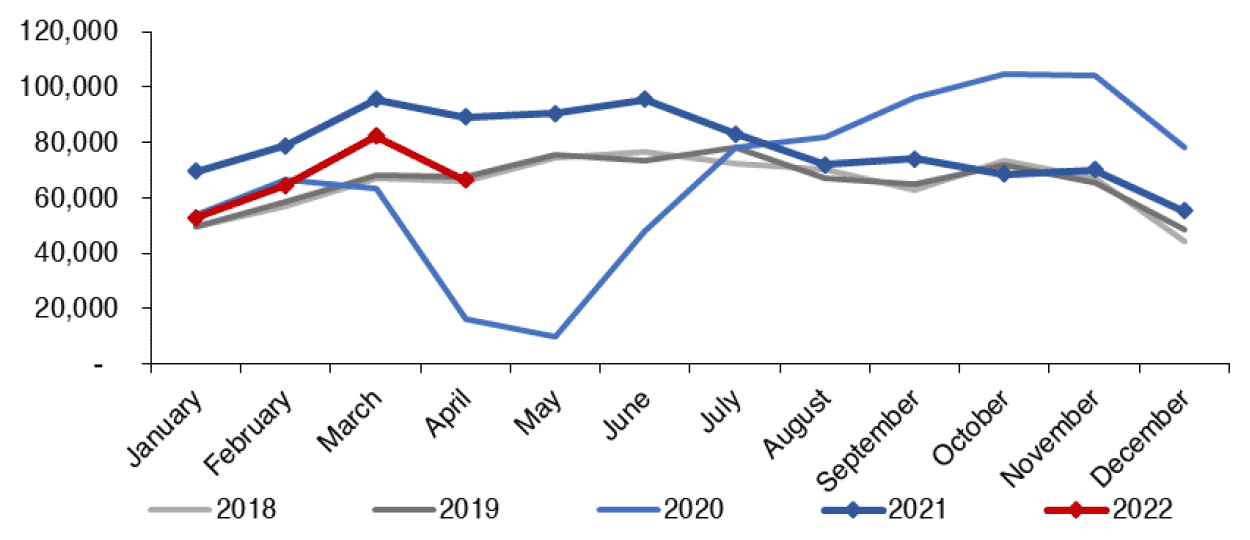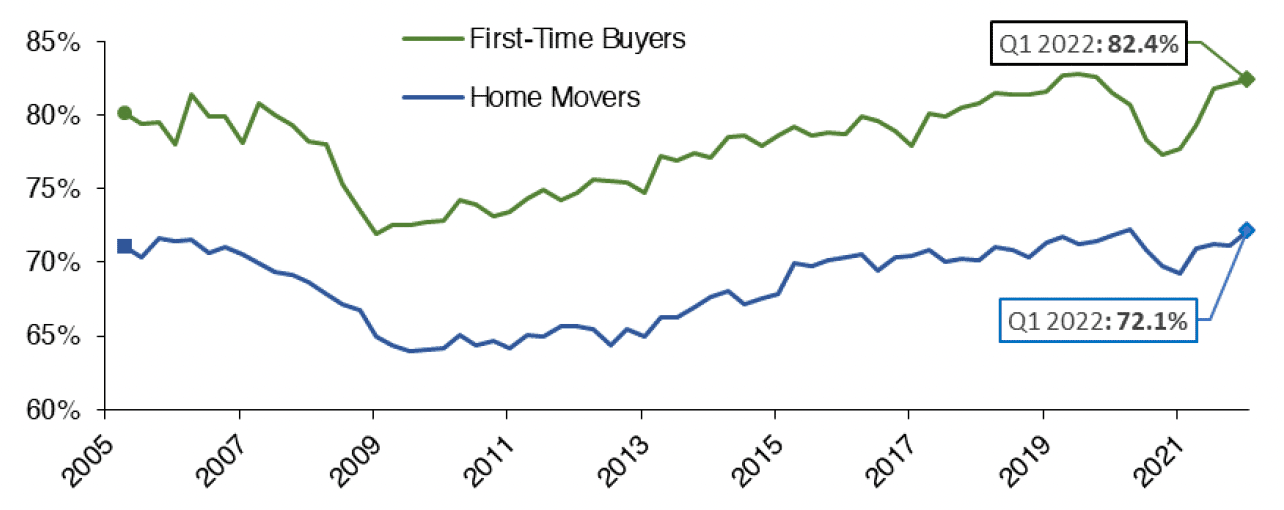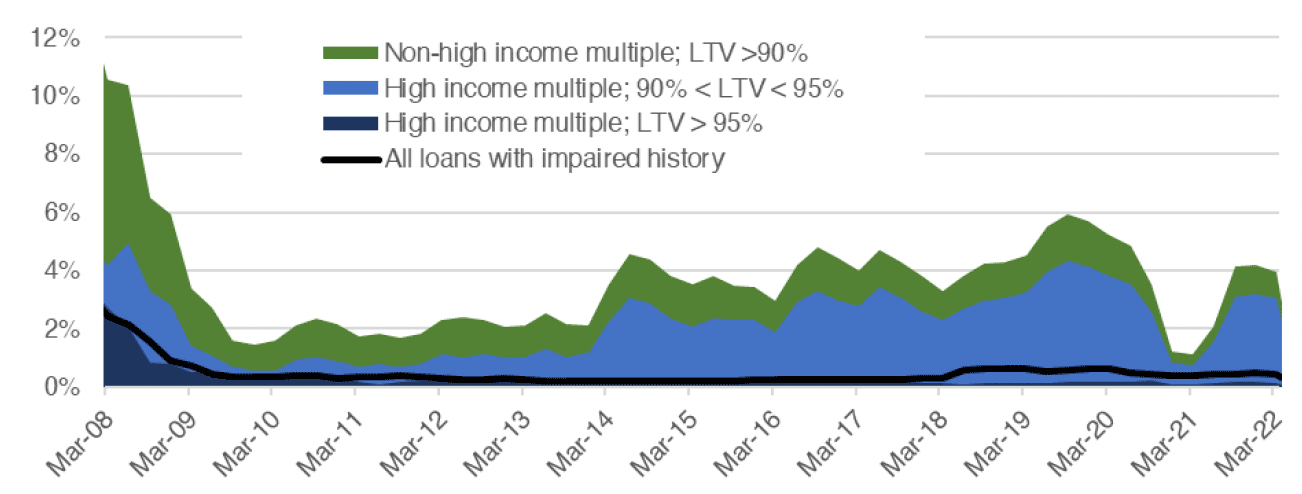Scottish Housing Market Review: Q2 2022
Scottish housing market bulletins collating a range of statistics on house prices, housing market activity, cost and availability of finance and repossessions.
5. Mortgage Approvals and LTVs
New Mortgage Advances
Chart 5.1 plots the monthly number of new mortgages advanced to first-time buyers and home movers in Scotland. There were 6,890 new mortgages advanced to first-time buyers in Scotland in Q1 2022, an annual decrease of 9.6% (-730). Meanwhile, there were 6,610 new mortgages advanced to home movers in Scotland in Q1 2022, an annual decrease of 27.4% (-2,490). Whilst the annual decreases for first-time buyers and home movers are large, this can be explained by the very high number of new mortgages advanced in Q1 2021 (see discussion in Sales section). Comparing the 12-month period to Q1 2022 against the previous 12 months, new mortgage advances to first-time buyers increased by 13.0% whilst the increase for home movers equalled 6.4%. (Source: UK Finance).

Source: UK Finance
Mortgage Approvals
Chart 5.2 plots the monthly number of mortgage approvals across the UK for house purchase (Source: BoE). Mortgage approvals for house purchase are the firm offers of lenders to advance credit fully secured on dwellings by a first charge mortgage. This data is a leading indicator of mortgage sales as it reflects activity early in the buying process.
Mortgage approvals for house purchase across the UK rebounded strongly following the lockdown in the second half of 2020, with mortgage approvals increasing from 9,922 in May 2020 to 104,806 in October 2020 (see Chart 5.2). Mortgage approvals have now returned to more normal levels, with mortgage approvals for house purchase 1.0% higher in April 2022 relative to the 2017-2019 average for the same month.

Source: Bank of England
Loan-to-Value (LTV) Ratios
In Q1 2022, the mean Loan-to-Value (LTV) ratio on new mortgages advanced to first-time buyers in Scotland stood at 82.4%, an annual increase of 4.7 percentage points. This likely reflects the return of high LTV ratio mortgages, whose availability fell substantially during the beginning of the coronavirus pandemic. Meanwhile, the mean LTV ratio for home movers in Scotland stood at 72.1% in Q1 2022, up 2.9 percentage points over the one year period. This is shown in Chart 5.3. (Source: UK Finance).

Source: UK Finance
Chart 5.4 shows that there was a reduction in new lending at high LTV mortgage ratios across the UK since March 2020 but the market is starting to recover. The share of gross mortgage advances across the UK in Q1 2022 with an LTV ratio greater than 90% was 3.9%, 2.8 percentage points above the share in Q1 2021 but 1.3 percentage points lower than the share in Q1 2020. There has been a slight recovery in lending which is both high LTV and high LTI (loan-to-income) over the quarter, with the share of gross advances classified as high LTV and LTI increasing to 3.2% in Q1 2022, up by 2.4 percentage points on Q1 2021 but 0.8 percentage points lower than the share in Q1 2020.

* Higher risk lending is classified by the FCA as an LTV over 90% and an income multiple greater than or equal to 3.5 for single income purchasers, or greater than or equal to 2.75 for joint income purchaser/s
Source: FCA
There has been a substantial increase in the number of high LTV products offered by mortgage lenders, with the number of 95% LTV mortgages products increasing from 14 in June 2021 to 347 in June 2022. This recovery could in part reflect the UK Government's Mortgage Guarantee scheme. The Mortgage Guarantee Scheme aims to increase the availability of 91% - 95% LTV mortgage products by providing a government guarantee that would compensate lenders a portion of their losses in the event of foreclosure. The scheme was launched on 19 April 2021 and will close on 31 December 2022. However, a number of high LTV products have been introduced outside this scheme. (Source: Moneyfacts Mortgage Treasury Report).
Contact
Email: William.Ellison@gov.scot
There is a problem
Thanks for your feedback